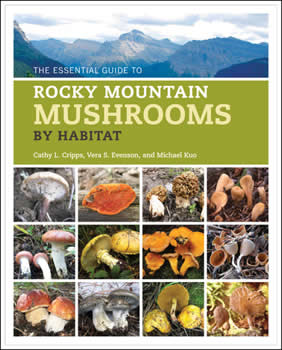The Essential Guide to Rocky Mountain Mushrooms by Habitat
A Book Review

The Essential Guide to Rocky Mountain Mushrooms by Habitat
Cathy L. Cripps, Vera S. Evenson, and Michael Kuo
University of Illinois Press, 2016
ISBN: 978-0252-081460
Whatever biological discipline tickles your fancy, inevitably, we tend to focus primarily upon our target groups, and often ignore the broader ecological picture.
This fine new book on Rocky Mountain (RM) fungi, by primary author Cathy Cripps and her mycological colleagues Vera Evenson and Michael Kuo, attempts to show us the broader perspective.
If we consider nature to be a tapestry of many threads, with the fungal world merely one colorful thread, then we cannot really understand the entire pattern without including the rest of that warp and woof. The fungi that we seek are intimately tied into the botany, zoology, geography and geology of a particular region or life zone. These deep relationships are beautifully illustrated in this new book.
Authors Cripps, Evenson and Kuo broke the RM region down into its distinctive habitats: from the unique and fascinating alpine zones to its broad swatches of species specific conifer forests to semi-arid shrublands to prairie grasslands and more. Typical macro-fungi that are found in each distinctive zone are well described and illustrated; novel fungi are also added to peak the interest of more experienced and thrill-seeking mushroomers, and those who wish to go deeper in their fungal studies. Each distinctive habitat or zone is well described, including the plants, animals and geography that define it, and how our too often ignored fungi fit neatly into the whole.
The inner cover shows a quick guide to fungal species found in the various habitats described within the book. Not every possible fungus is shown, but those most likely to be encountered are listed, with a page reference. The inner back cover shows Rocky Mountain landmarks such as distinctive mountain ranges found within the Rockies. This would allow you to easily target areas in which to search for fungi in your ecological zone of choice. This book is designed primarily for somewhat experienced mushroom hunters, and provides an entire new way of looking at fungi: as parts of their ecological wholes.
Cripps wrote most of the text, including the introduction, most of the habitat descriptions, quick guide, key and index. Cripps and Evenson co-authored the intro to semi-arid shrubland. Evenson wrote up the ecologies of the American Prairie and the Ponderosa Pine forests. One couldn’t ask for better guides to these distinctive habitats and their fungal denizens than Cripps and Evenson: between the two of them, they have over 100 years of collecting experience in the Rocky Mountain region! Cripps and Kuo co-authored the ecological intros to the Lodgepole pine forests and the Spruce-fir forests. Species description authors were primarily correlated with photo contributions. Some of the photos used were excellent, others merely serviceable, but all were large format and emphasized important morphological features. Each mushroom photo was coupled with its species description on a single page. Spore print color was emphasized, but few to no microscopic details were given. This might prove frustrating to those who wish to go deeper in their identifications. But this book is not meant to be an exhaustive compendium of deep description, but rather an overview of RM fungi in their natural habitats, with the focus on macro-features.
Consider this book to be a Myco-Eco-Tour of the Rockies, led by authors who are intimately conversant on both the fungi and the ecosystems in which they exist and thrive. It was a delight to peruse some of the more unusual habitats and their accompanying fungi which are described in this book, like the snowmelt fungi and burned forests and alpine forest, where the “trees” don’t grow above knee-height, and the air is so very, very thin! Believe me, it’s worth the crawl to see these special places, and as we all know, the slower you go, the more you’ll see!
Not only is this book a great introduction to the fungi of the Rockies, where to find them, and how to recognize them once you do, but it is also a pleasure to read.
I whiled away quite a few happy hours on my plane flight home from Sydney, Australia, reading those “you are there” descriptions of Rocky Mountain habitats: a nice reintroduction to our own glorious NA continent, after being well-steeped and awestruck over the marvelous alien biology of the magical land of OZ!
Released in paperback form, this thin and lightweight volume can be easily and readily carried into the field. I highly recommend buying this book and carrying it along if you plan on hunting mushrooms in the Rockies. Even if you are merely an armchair traveler, this book will bring the experience of hunting mushrooms in the Rockies right up to your own front door, no jet lag necessary.
Kudos to authors Cripps, Evenson and Kuo for another job well done. I can’t wait to try the book out in the field this summer.
Debbie Viess
April 28, 2016
First published in Mushroom the Journal, MJ Winter/Spring 2016, Issue 115; Vol. 32, No. 1-2

 back to top
back to top